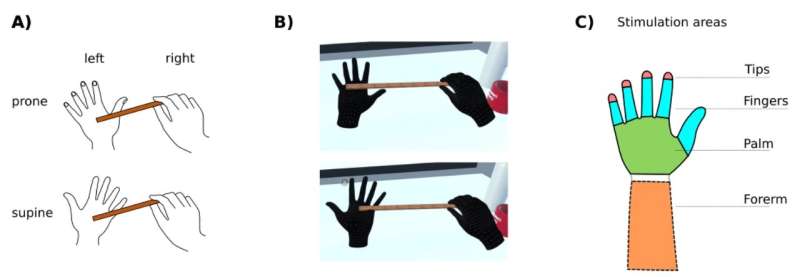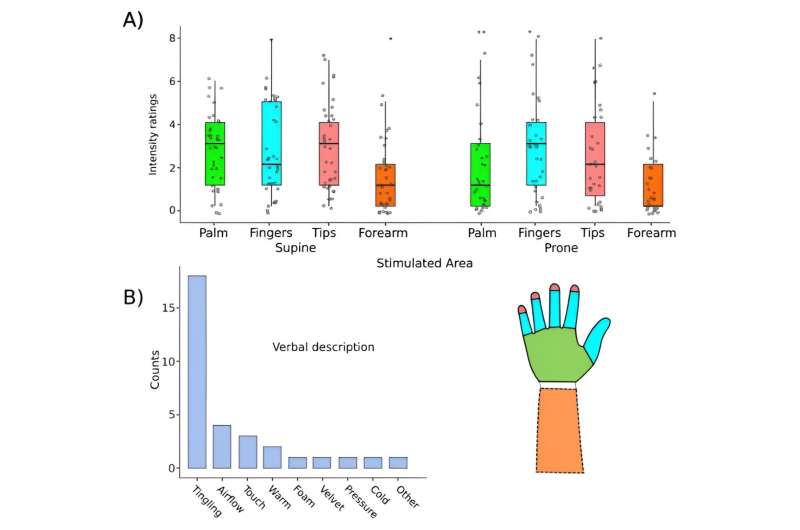September 25, 2023 feature
This article has been reviewed according to Science X's editorial process and policies. Editors have highlighted the following attributes while ensuring the content's credibility:
fact-checked
peer-reviewed publication
trusted source
proofread
Research team uses immersive VR to shed light on tactile gating and 'phantom touch illusion'

If you've ever tried to tickle yourself, you may not have succeeded. This is due to your nervous system suppressing the expected sensation of your own actions, a mechanism known as tactile gating. Until now, this mechanism has been understood as a complex sensory process occurring in response to the activation of tactile receptors.
However, new research by a team from Germany's Ruhr-University Bochum suggests that body schema can also play a part in tactile gating. Their work, titled "Phantom touch illusion, an unexpected phenomenological effect of tactile gating in the absence of tactile stimulation," is published in Scientific Reports.
Recent work in PNAS has shown that the predictability of a self-touch pattern determines the measure of tactile gating. However, the same study also shows that tactile gating can occur in response to non-predicted input, indicating that non-specific input reduction may also come into play.
Spurred by virtual reality (VR) users' informal reports of "phantom touch illusion"—an indistinct sense of touch resulting from similar lifelike actions within a VR game, for example—the researchers of this new study sought to investigate how the tactile gating process would work in the absence of an actual sensory tactile signal.
They hypothesized that if a predicted touch could effect such a sensation within the VR context, then neurologically it should work the same way as tactile gating in reality. To investigate, they devised an experimental test in which the test subjects (36 individuals aged 21–42, 14 of whom were male) wore a head-mounted display that would track their hand movements.
Within the simulated virtual environment, each participant could see their virtual hands, but could not see their forearms or other parts of their bodies. On a table before each participant were ordinary objects of realistic scale, including two sticks, each about 30 cm long and 2 cm wide. Each participant used a virtual stick to touch and stroke their virtual hands according to instructions from the researchers, who noted their descriptive responses and ratings of intensity, on a 0–10 scale, on any sensations they could feel.

During control testing, the participants did not wear VR headsets, and followed similar researcher instructions to touch and stroke each of their hands using laser pointers that they switched on and off at various points during the testing.
Among the notable results, 32 of the 36 test subjects (89%) described a sensation that was either electric, prickling, static, tingling or "like wind passing through the hand" during the test phase of the research. All 32 of the positive respondents confirmed that the feeling corresponded to the stick's position on the virtual hand. Some said that they could feel a sensation before they were even asked.
Significantly, 50% of those who specified a sensation of tingling in their hand said they could feel it during the test phase; during the control phase, only 13% reported this while the laser was on, and 9% reported it with the laser off. Furthermore, most of the subjects reported the same sensation while touching their non-visible forearm during the test phase.
Though this study shows that visual cues may primarily drive tactile gating, the test subjects' reports of phantom touch illusion on a non-visible body part suggest the involvement of an additional factor.
Information from other senses may also play a part, as the paper suggests: "for example proprioception, or top-down input from the body schema." In addition, recent research in iScience suggests that tactile gating may be a separate process from tactile attenuation.
The authors of this newest study note that further research on "other modalities and input sources (such as body schema) on tactile gating" is needed.
More information: Artur Pilacinski et al, Phantom touch illusion, an unexpected phenomenological effect of tactile gating in the absence of tactile stimulation, Scientific Reports (2023). DOI: 10.1038/s41598-023-42683-0
© 2023 Science X Network





















